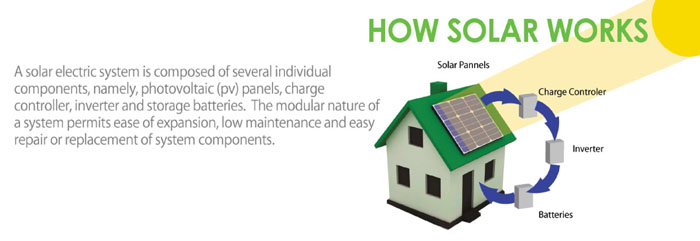HOW IT WORKS
A solar electric system is composed of several individual components, namely, photovoltaic (PV) panels, charge controller, inverter and storage batteries. The modular nature of a system permits ease of expansion, low maintenance and easy repair or replacement of system components.
PHOTOVOLTAIC PANELS
The cells of a PV panel are manufactured to produce an electric current, when exposed to sunlight. The more light that the panel receives, the greater the amount of electricity produced, up to a maximum, limited by the rated capacity of the panel.
CHARGE CONTROLLER
Device wired between the PV panels and the storage batteries. When the battery bank is fully charged, the controller cuts the power to prevent overcharging.
INVERTER
An electronic device that converts low voltage current (DC),solar generated electricity, into alternating current (AC),used in households. Combining batteries with an efficient inverter allows one to power standard electrical loads.
BATTERY
Batteries are used to store unutllized electricity in the form of low voltage, direct current (DC), produced by the solar panel. This energy can be used at night, or in the event of severe weather conditions, where the sunlight is insufficient.
Storage batteries for solar electricity are special rechargeable deep cycle batteries , designed to provide a steady amount of power over extended periods of time.
Our systems are designed with two to three days of autonomy, that is; systems will operate for two to three days without sunshine, for the designed electrical requirements. If the load on the system is increased above the design, then the reserve capacity will be reduced.



